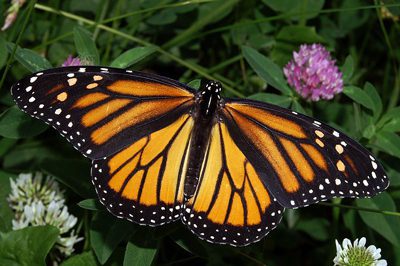Milkweed and metamorphosis

Earlier this summer, I visited a Uwharrie pitcher plant bog at the right time to spot an interesting wildflower in bloom – swamp milkweed (Asclepias incarnate). Similar to the bright orange butterfly weed seen on many roadsides, this version of milkweed is considerably taller, and instead of a vibrant sunset-orange color, it is a more subdued and graceful light pink.
Swamp milkweed is native to North America and grows in damp soils, which made a bog the ideal habitat. They have specialized roots that allow them to grow in areas too wet for some other species, due to lack of oxygen in those environments. Most wetland plants have one or more special characteristics that provide them an advantage and enable them to survive in these less than ideal conditions.
 Milkweed attracts a lot of butterflies due to the large amount of nectar it produces. This is probably why the more common, orange variety is called “butterfly weed.” Milkweed attracts monarch butterflies in particular. A friend of mine has planted a native wildflower garden in her backyard, and one of the species she chose to plant there there is swamp milkweed. This has attracted some monarch caterpillars, which are just getting ready to form their chrysalis and begin the next phase of their life cycle.
Milkweed attracts a lot of butterflies due to the large amount of nectar it produces. This is probably why the more common, orange variety is called “butterfly weed.” Milkweed attracts monarch butterflies in particular. A friend of mine has planted a native wildflower garden in her backyard, and one of the species she chose to plant there there is swamp milkweed. This has attracted some monarch caterpillars, which are just getting ready to form their chrysalis and begin the next phase of their life cycle.
Monarchs are unique among butterflies in that they migrate north and south, similar to birds. They go south starting in August, and migrate north in the springtime. Their range is from Mexico and southern California to Canada. However, not one individual makes the whole trip – this is done over multiple generations. A lot of species of butterflies live only a few weeks, but monarch butterflies can live for seven or eight months. The last generation of the summer overwinters in the south and do not reproduce until February or March. The reason they migrate to warmer areas instead of hibernating is believed to be because their ancestors were tropical butterflies who could not withstand cold temperatures.
 They go through four life stages, from egg to larvae to pupa to adult. Eggs are laid in summer months, exclusively on milkweed plants. After four days, the caterpillars hatch and eat and grow quickly for two weeks. They then form a chrysalis (the pupa stage), which is basically a silk encasing. It is while they are in the chrysalis that hormonal changes transform them into the adult butterfly, a process known as metamorphosis. Right now, the silk casing that encloses the small caterpillar in my friend’s garden is a vivid sleek green, but this will age and turn brown and papery before the orange and black striped monarch adult emerges, which should occur in approximately two weeks.
They go through four life stages, from egg to larvae to pupa to adult. Eggs are laid in summer months, exclusively on milkweed plants. After four days, the caterpillars hatch and eat and grow quickly for two weeks. They then form a chrysalis (the pupa stage), which is basically a silk encasing. It is while they are in the chrysalis that hormonal changes transform them into the adult butterfly, a process known as metamorphosis. Right now, the silk casing that encloses the small caterpillar in my friend’s garden is a vivid sleek green, but this will age and turn brown and papery before the orange and black striped monarch adult emerges, which should occur in approximately two weeks.
Monarch numbers have been in decline in recent years. This may be due to a variety of factors including parasites, loss of forested habitat for overwintering and an invasive species of milkweed that is toxic to them. Much is still unknown about this jet-setting butterfly, including how they know how to get back to their overwintering grounds, but a citizen-science project called Journey North is helping answer some of those questions. You can visit their website and report sightings of monarch butterflies and view sightings other people have made. This information provides insight on their migration patterns and range, which is an important first step to know how the species is doing and how to help. To learn more about monarchs and report your own sightings, you can visit: http://www.learner.org/jnorth/monarch/.
This is a remarkable species. A tiny individual caterpillar that emerges almost magically as a butterfly, and then travels (sometimes in groups of hundreds or more) for thousands of miles – an extraordinary natural phenomenon to see. They are a great reminder of the beauty and magnificent complexity of nature.